12 Must-Have Features for Makeup and Skincare Stores

eCommerce is booming for beauty brands, making it vital to focus on features for makeup and skincare stores.
Buying beauty products online should feel effortless. But for most customers, it often isn’t. Clunky websites, confusing menus, a lack of a user-friendly interface, and slow checkouts frustrate shoppers and send them running to competitors.
As an entrepreneur in the booming beauty eCommerce space, that’s your biggest challenge when trying to build a user-friendly eCommerce store to sell makeup and skincare products.
The struggle to stand out in a crowded, cut-throat market and deliver a seamless, satisfying shopping experience for your customers is real.
So the question is → how do you craft a website that’s not just beautiful, but also easy, intuitive, and built to convert? And what are the top must-have features for makeup and skincare stores?
That’s precisely what we are discussing in the blog post.
Let’s start
What Are Must-Have Features for Makeup and Skincare Stores?
There are thousands of websites selling makeup and skincare products. How do you ensure that yours is the go-to choice for your customers?
The shortest answer is to provide the best user experience on your website.
You can ensure this by creating a website that is easy to navigate and shop on. Your website must help customers make informed decisions without any confusion.
Here are 12 must-have features for makeup and skincare stores that your website must have to make shopping easy and delight customers while ensuring higher skincare store conversions.
1. AI-powered Interactive Skin Analyzer
An AI-powered interactive skin analyzer enables your customers to discover the most suitable skincare and makeup products customized to their unique skin characteristics. See, each of your customers is unique and has different skincare requirements, which makes their skincare and makeup routines change based on their skin type.
However, most of your visitors may not know the best products for their skin, as the ideal products depend on diverse skin qualities, such as:
— The level and frequency of exposure to the sun.
— The type of skin, such as oily, dry, combination, etc.
— Skin concerns, such as acne, pigmentation, aging, and redness.
— The tone of the skin, such as fair, medium, or dark skin.
— Size of skin pores, such as large or clogged pores.
Therefore, it would be hard for your customers to find ideal skincare products for themselves.
With an interactive and AI-powered skin analyzer tool, you can help customers buy products that fit their needs. It is also one of the top high-converting eCommerce features that can help you bring in more sales.
Top skincare and makeup eCommerce stores, such as Minimalist, utilize these tools to provide their users with a unique and personalized shopping experience.
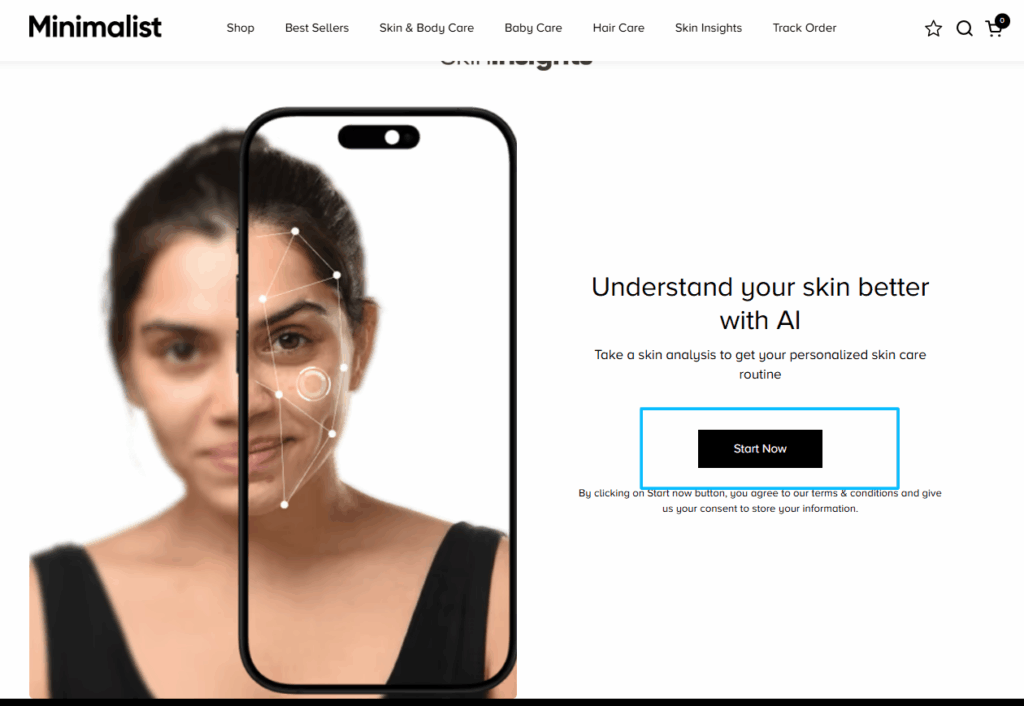
Credit – Beminimalist.co
This is how the tool will work:
- Create a set of questions that your users can answer about the skin.
- Have the AI tool analyze the answers to understand the ingredients they need.
- Let the AI tool find products with these ingredients from your product portfolio.
- Show all these products to the users for the best results.
You can also add further filters, such as price, ratings, and customer reviews, to customize the results based on your visitors’ preferences.
When planning to add such a tool to your store, you don’t need to build it yourself. There are several AI skin analyzer tools that you can integrate with your eCommerce store for this, such as Haute AI, IQONIC AI, and the AI skin analysis & tester by Perfect.
The response of your users will certainly help you understand why this is one of the top features for makeup and skincare stores.
AI-powered personalization tools like skin analyzers are proven conversion boosters. But adding these features requires careful planning to avoid slowing down your site.
Pro Tip: Learn how to balance advanced features with speed in our guide on what is Shopify speed optimization to ensure your store stays fast while delivering personalized experiences that convert.
2. Virtual try-on (VTO) for Makeup Products
Virtual try-on is one of the standout features for makeup and skincare stores selling makeup and skincare products. VTO enhances the online shopping experience by enabling customers to see how products appear on their faces in real time. This is possible with the help of augmented reality (AR) and artificial intelligence.
This technology bridges the gap between physical and digital shopping by enabling users to test foundations, lipsticks, eyeshadows, and more virtually.
Top brands, such as L’Oreal, are already using these features for makeup and skincare stores on their websites to deliver an exceptional shopping experience for users.
Using L’Oreal’s VTO solution, visitors can check how different shades of mascara, eyeshadow, lipstick, and other products will look on them and select the most suitable one based on their skin tone and other features.

Credit – L’Oréal
VTO is among the most beneficial features for skincare and makeup stores as it helps with the following:
- Customers make quicker and more confident purchase decisions after virtually trying products, resulting in increased sales.
- Accurate previews reduce dissatisfaction and product returns, save costs, and improve business efficiency.
- Offering advanced features like VTO sets brands apart, attracting consumers and enhancing their brand reputation.
- Customers can select the best skincare and makeup products that suit their unique skin features and goals.
- Interactive and personalized experiences encourage visitors to spend more time on your site, helping you build brand loyalty.
3. Ingredients Section
Modern consumers want to know the ingredients of the products they buy. They seek transparency and clarity about what goes into the skincare and makeup products they use.
Displaying a full, easy-to-read ingredient list on product pages builds trust and credibility. It shows customers that you have nothing to hide, which makes the section one of the must-have features for makeup and skincare stores.
According to a report by Euromonitor, nearly half of Asia Pacific consumers are willing to pay up to 50% more for beauty products with clearly communicated, science-backed ingredients. Ingredient formulation is a desired skincare feature for nearly 20% of users, making it one of the most high-converting eCommerce features to have in your makeup and skincare store.
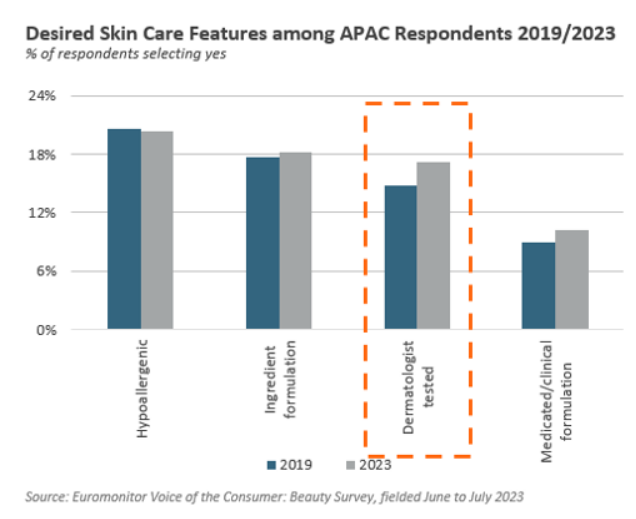
Credit: Euromonitor
What makes an ingredients section vital is the intent behind it — transparency. Leading brands leverage this section to educate, build trust, and ensure better skincare store conversions. This is something impossible to achieve with even the most detailed product descriptions.
For example, Sephora has the Ingredient Callouts section. The section shows both included and excluded ingredients, such as “paraben-free” or “no phthalates”.
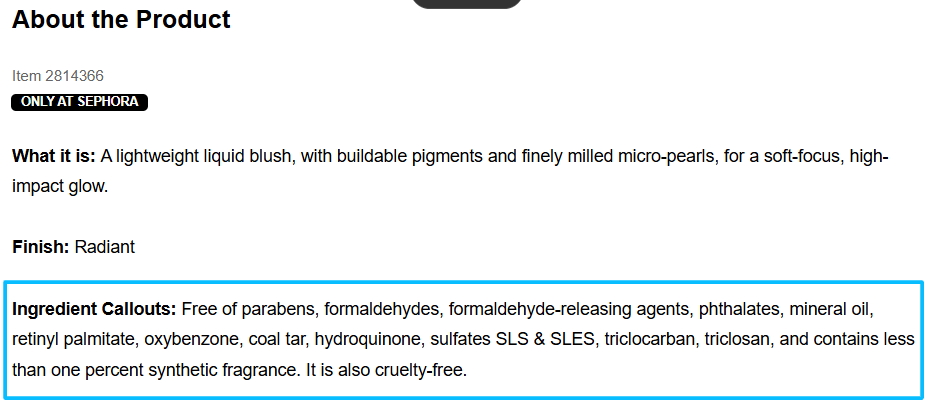
Credit – Sephora
There are several benefits to adding an ingredients section to your makeup and skincare eCommerce store, such as:
- A clear ingredients listing helps customers understand what’s in a product and makes them confident about using the product
- Users with sensitivities, allergies, or lifestyle choices, like vegan, can easily pick safe products.
- Ingredient sections inform visitors whether the product contains the ingredients they are looking for, increasing the likelihood of a sale.
- As customers know what’s in a makeup or skincare product, they are unlikely to return it.
4. UGC-focused Before and After Gallery
Customers often want to know how they will look after using a product.
The best way to help them is to use a user-generated, before-and-after gallery. It is also a smart way to show how your products are helping other customers. Whether it’s acne treatment, lip gloss, or anti-aging creams, these visual testimonials help create trust and authenticity.
Yotpo reports that in its survey, 77% of respondents stated they prefer to see customer photos over brand photos when making a purchasing decision.
That’s why a UGC-focused before-and-after gallery is one of the top features for makeup and skincare stores.
In fact, many leading makeup and skincare eCommerce stores, like Maybelline and Skin+Me, utilize this feature on their websites.
Skin+Me has taken this a step further by curating and publishing full customer journeys, complete with a UCG-focused before-and-after gallery.
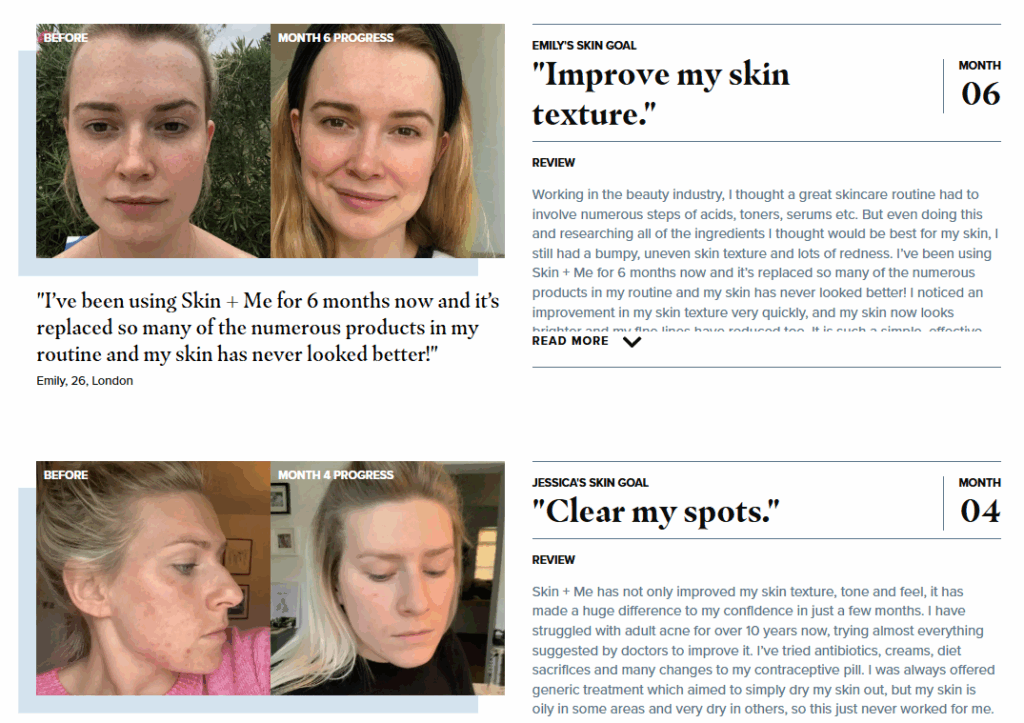
Credit: Skin+Me
A user-generated before-and-after gallery offers you numerous benefits:
- Build a community around the brand to increase user engagement.
- Provide social proof to establish trust and credibility for your brand.
- Show real results for users with similar skin types or concerns.
- Display happy customers to new visitors who are skeptical.
As one of the essential features for makeup and skincare stores, the gallery is also easy to add to your store, either on product pages or a separate page showcasing multiple products.
There are also pre-built before-and-after plugins or slider tools compatible with your platform, like the Before & After Slider App for Shopify.
5. Ingredient and Allergen Filter
Skincare and makeup are highly personal. What works for one customer may not work for another, especially when allergens or harsh chemicals are involved.
Many users actively seek out vegan, organic, or cruelty-free products while avoiding sulfates, parabens, and other irritants. Often, these choices stem from allergies, skin sensitivities, or ethical lifestyles.
A study by Verified Market Research reveals that customers are increasingly aware of the importance of ingredients in maintaining healthy skin. This is one of the factors driving the growth of the anti-inflammatory ingredients market.
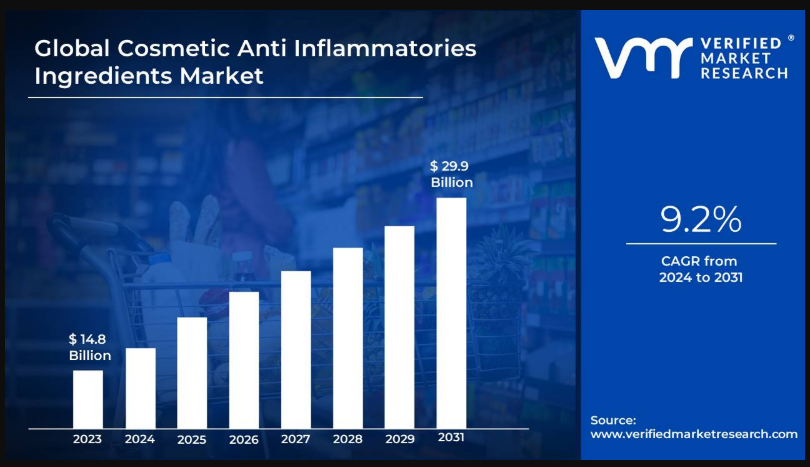
Source: Verified Market Research
That’s why adding ingredient and allergen filters is one of the top features for makeup and skincare stores. Hence, adding a filter that allows users to find products they want quickly based on ingredients and allergens can improve the user experience, leading to better sales.
There are several benefits to adding the ingredient and allergen filters, such as:
- Let users instantly narrow down products based on their needs
- Speed up purchases and reduce the number of returns
- Position your store as transparent and customer-first
- Improves brand trust and reliability through transparency
- Build a niche audience seeking vegan and cruelty-free products
You can easily add these filters to your store. You can develop a custom plugin in-house or hire an eCommerce development agency that specializes in adding custom features for makeup and skincare stores.
These filters on your skincare and makeup eCommerce store enhance user experience and help position you as a transparent and inclusive brand that meets the needs of today’s conscious shoppers.
6. Rewards Points and Loyalty Programs
The quickest way to improve profit in the industry is to reduce customer acquisition costs and retain existing customers with customer-friendly rewards and loyalty programs. Although this is one of the common features for makeup and skincare stores, they still work incredibly well.
Beyond reducing acquisition costs and exceeding customer expectations, a customer-friendly rewards point and loyalty program can:
- Boost repeat purchases
- Increase average order value
- Reduce your ad spend
- Improve social media engagement
- Deepen the customer’s brand loyalty
All these help your business increase sales and profitability without increasing your customer acquisition cost. Reward points systems work by offering incentives or discount codes for valuable actions:
- Purchases
- Product reviews
- Social shares
- Referrals
- Birthdays
Customers earn points that can be redeemed for discounts, free shipping, or exclusive products.
In fact, many businesses have resorted to offering reward points and a loyalty program to ensure value-adding post-purchase optimization.
Here are a few examples:
# Beauty Insider by Sephora
- Users: 31 million
- Structure: Tiered (Insider, VIB, Rouge), points-based
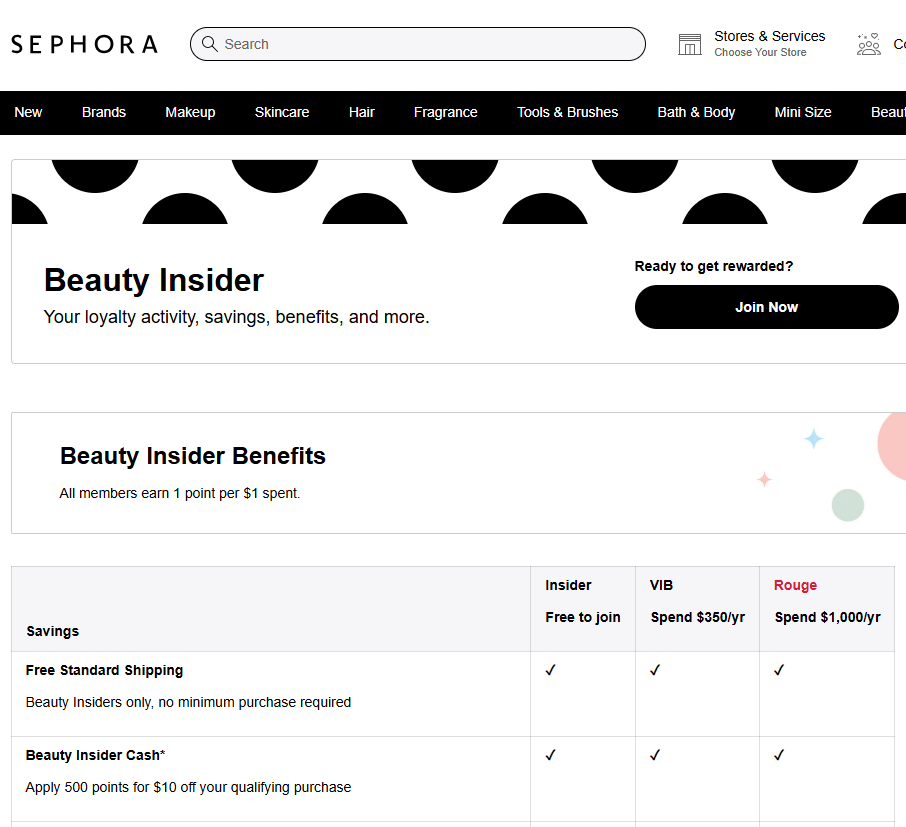
Source: Sephora
Members of the program can earn points for every purchase, which can be redeemed for products, samples, exclusive experiences, and early access to sales. Along with other top features for makeup and skincare stores, Sephora has strategically used the feature for more sales and user retention.
# Ulta Beauty Rewards by Ulta
- Users: 42 million
- Structure: Tiered (Free, Platinum, Diamond), point-based
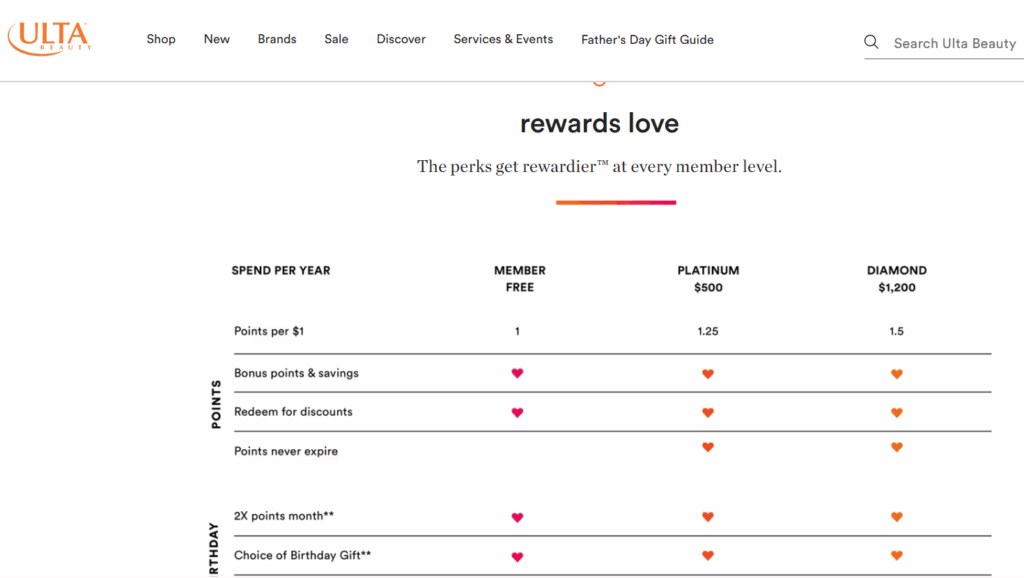
Source: Ulta
Members of the program can earn points for every dollar spent based on their tier. It also offers frequent bonus point events and a co-branded credit card for earning points outside Ulta.
You can implement a rewards program using tools like Smile.io or LoyaltyLion, which integrate with platforms like Shopify, Magento, and WooCommerce.
As such, that’s why rewards points and loyalty programs are among the top features for makeup and skincare stores that want to increase makeup store conversions.
Loyalty programs work best when paired with strategic conversion optimization. Beyond just offering points, you need to optimize every touchpoint, from product pages to checkout, to maximize repeat purchases.
Pro Tip: If you’re looking to boost retention and conversions simultaneously, check out our proven strategies on how to improve the conversion rate for your Shopify store to turn loyal members into high-value customers.
7. Subscription Models
Subscription models are another must-have feature for makeup and skincare stores. They provide convenience for customers and recurring revenue for your business. As such, they are becoming a common feature for makeup and skincare stores.
In fact, according to The Business Research Company, the subscription eCommerce market is expected to grow at an impressive Compound Annual Growth Rate (CAGR) of more than 65% from 2024 to 2025.
One of the largest segments with consistent growth is the replenishment-based models that skincare and makeup brands rely on.

Source: The Business Research Company
Both customers and eCommerce brands stand to gain immensely from these subscription models.
Customers benefit from automatic restocks of essentials, such as cleansers, serums, and moisturizers, without the hassle of reordering. Brands enjoy benefits such as predictable revenue, higher customer retention, and improved customer lifetime value.
As a business, there are several ways you can utilize these features to serve customers better and ensure predictable revenue by ensuring high makeup store conversions.
You can offer:
— Auto-replenishment subscriptions (e.g., every 30, 60, or 90 days)
— Member-only discounts
— Early access to product drops
— Surprise samples with deliveries
These programs drive consistent sales while also ensuring continuous engagement with your brand, which makes this one of the top must-have features for makeup and skincare stores.
There are many tools that makeup and skincare businesses can use to offer this feature to their customers.
Here are a few top eCommerce subscription tools:
- Appstle Subscriptions App for Shopify
- Chargebee for Magento
- WooCommerce Subscriptions for WooCommerce
These tools offer flexible billing and shipping intervals and are easy to install. For greater control and customization, you can also develop these systems in-house.
8. Beauty Vlogs and Tutorials
Beauty vlogs help customers visualize how products work and how they will look on real people. A tutorial is much more than a marketing tactic that teaches them how to use a product properly for optimal results.
Although these vlogs and tutorials may not come to mind as one of the must-have features for makeup and skincare stores, they can work incredibly well to build brand awareness.

Source: Fenty Beauty
According to a survey conducted by WyzOwl, 78% of customers prefer to watch short-form videos to understand a product better.
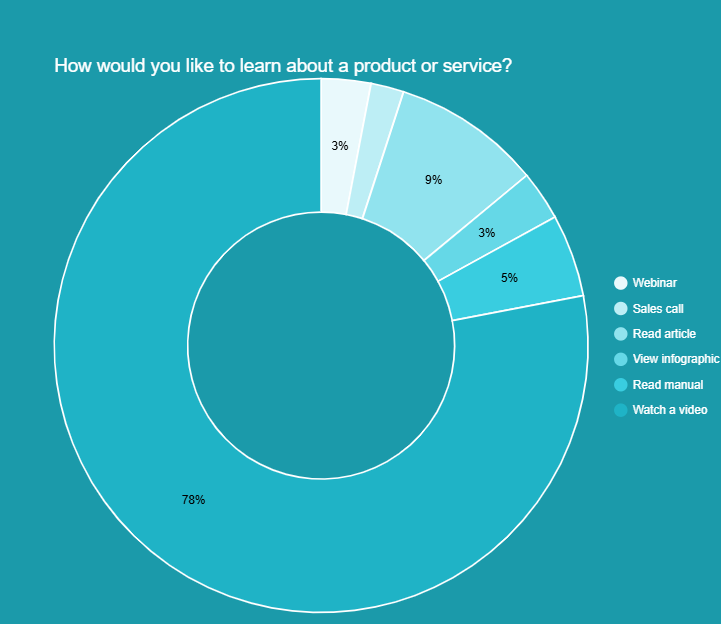
Source: Wyzowl
In an industry like skincare and makeup, application techniques and product textures matter more. Hence, producing and adding video content and short-form tutorials are vital to remove guesswork and build buyer confidence.
This is one of the most effective features for makeup and skincare stores that want to educate their users to build trust and authenticity.
There are several ways you can use these vlogs and tutorials:
- Explain routine for sensitive skin, acne-prone skin, anti-aging, etc.
- Show product use, such as layering serums or using mascara.
- Show before-and-after results of using certain products.
- Compare shades or formulations across skin tones.
- Share current and latest industry trends.
You can add these videos to product pages, blogs, or landing pages. Social platforms like YouTube, Instagram, and TikTok are ideal for publishing these videos.
There are several ways to create these videos, as well.
- Work with influencers in the niche and have them create video content and tutorials for you.
- You may create videos in-house by hiring professional actors.
- Ask your followers to share UGC tutorials and vlogs on social media, which you can then integrate into your store.
Using platforms like Tolstoy or Videowise can help you display shoppable videos on your website, as well. They also don’t slow down your store, no matter the eCommerce platform you use.
If you are a brand that uses UGC, content, and influencer marketing to bring in new audiences and retain the existing ones, this is one of the most crucial features for makeup and skincare stores you must focus on.
However, one thing to keep in mind is to focus on keyword research and search engine optimization to ensure your target audience finds you, and conduct performance monitoring to understand which blogs perform better.
9. Product Comparison on Beauty eCommerce Websites
Skincare and makeup customers are often very selective. This is typical of the customers in the beauty sector.
With dozens of similar products, such as two moisturizers or five foundations, they hesitate to choose a specific product. This might also prolong the buying decision.

Source: Fenty Beauty
You can easily remove this dilemma using a product comparison tool that helps create urgency and encourages them to make faster, more confident decisions. This makes the product comparison one of the must-have features for beauty websites.
Without clear comparisons to help consumers better understand products, they may leave your site to research. Even worse, they might buy from a competitor who makes the choice simpler.
Adding a product comparison option is one of the most effective features for makeup and skincare stores to help customers make faster decisions.
Here are a few more benefits of offering a product comparison feature:
- Simplifying the decision-making process leads to quicker purchases
- Help customers choose between similar products by showing differences side-by-side
- Keeps users engaged on your site longer as they don’t need to research elsewhere
- Showing full ingredient lists, specs, and pricing in one place signals transparency
As a makeup and skincare eCommerce store, you can include several comparison options on your store:
- Ingredients and formulations
- Skin type suitability, such as oily, dry, or acne-prone
- Coverage, texture, finish, etc., for makeup
- Price, quantity, and usage frequency
- Customer feedback and reviews
- Product formulation
As your customers compare products with each other, they will be able to make a faster purchasing decision, leading to more sales and fewer bounces.
You can build the feature in-house or work with third-party agencies specializing in the eCommerce industry to build custom features for makeup and skincare stores.
10. Problem-based Filters for Beauty Products
Skincare and makeup buyers rarely shop by product type alone. They shop for problems they want to solve.
Whether it is acne, dullness, hyperpigmentation, or fine lines, enabling shoppers to filter products based on specific skin concerns can increase your makeup store’s conversion rate.
One of the leading makeup and skincare brands, Estee Lauder, has used this filter predominantly on its store’s main menu. Along with other must-have features for makeup and skincare stores, this works incredibly well for them to help users quickly find products they want.
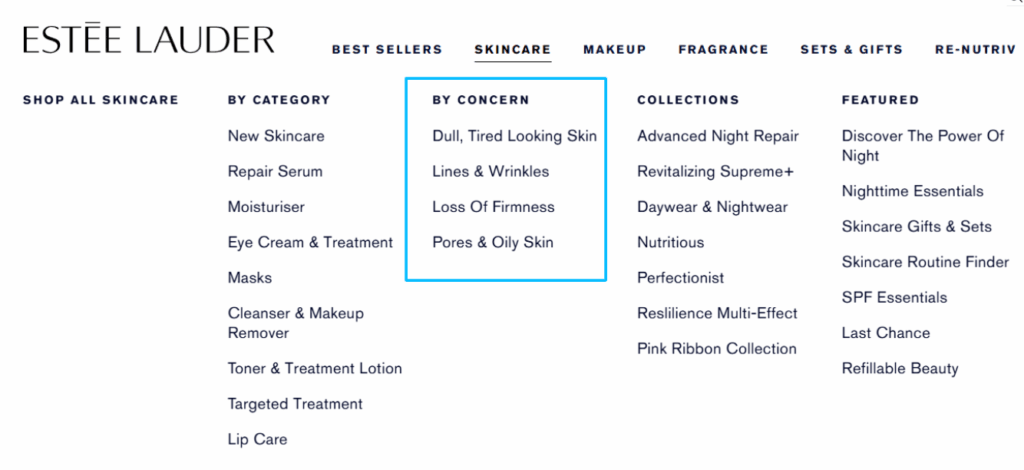
Source: Estee Lauder
As shown above, you can use several concerns your potential customers face, such as:
– Acne-prone skin
– Dark spots or pigmentation
– Anti-aging
– Sensitivity or redness
– Oily, dry, or combination skin types
Although these features for makeup and skincare stores are easy to add, the difference they make in user experience is huge, as customers can find products, understand product details and usage instructions, and buy them based on the issues they want to solve.
You can develop these filters in-house or hire an eCommerce website designer agency to help you.
There are also plugins you can use for this purpose, such as:
- Boost AI Filter and Search for Shopify
- FacetWP for WordPress
- Amasty’s Improved Layered Navigation for Magento
Adding filters based on the very problems your users want to solve is a great feature to speed up product discovery.
Problem-based filters for makeup and skincare eCommerce stores help:
- Offer a custom experience to enhance customer satisfaction and increase conversion rates.
- Build trust by positioning your products as solutions to real problems.
- Eliminate decision dilemmas by taking customers directly to the products they need.
11. Live Chat Option with Beauty Experts (Dermatologists & Cosmetologists)
Skincare and makeup customers are flooded with product choices. However, they are unsure what suits their skin type, tone, or routine.
Offering live chat with certified dermatologists or cosmetologists bridges this gap by providing instant, expert-backed guidance.
In the beauty eCommerce sector, this means higher trust, better product matches, reduced returns, and consultations with dermatologists and cosmetologists can ensure just that.
McKinsey & Company states in a report that personalization encourages nearly 80% of customers to make repeat purchases from a company and recommend the brand to family members or friends.
And it’s quite easy to understand why the live chat option is among the top features for makeup and skincare stores.
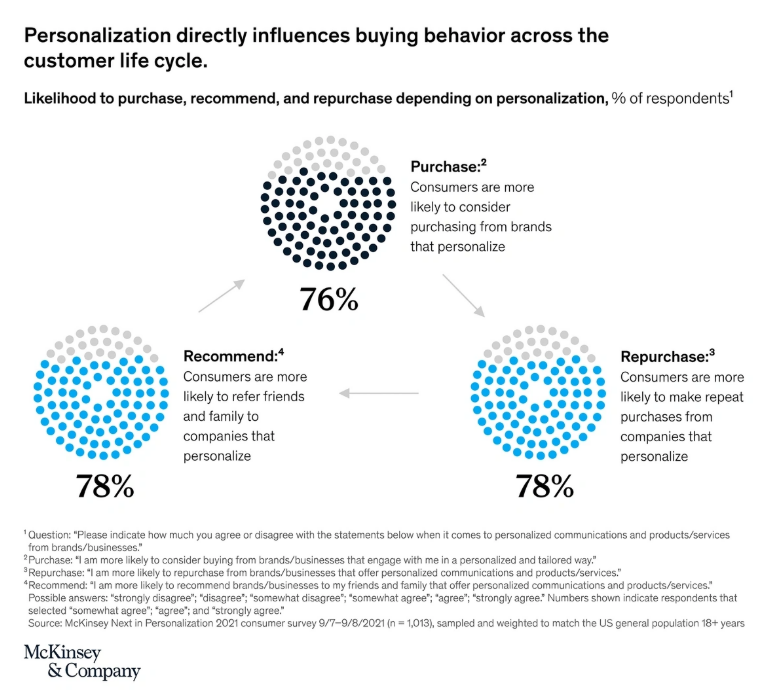
Source: McKinsey & Company
You can offer a personalized shopping experience to your users via live consultations and help customers in diverse ways:
- Matching foundation to skin tone
- Building a step-by-step skincare routine
- Understanding allergic reactions or sensitivities
- Choosing actives (like retinol or AHA) based on skin type
- Guiding customers with chronic concerns like acne or rosacea
You can implement this feature using tools like Tidio, Gorgias, or LiveChat and integrate them with scheduling apps, like Calendly, for longer sessions.
If your brand is small, you can start small by partnering with freelance dermatologists or skin consultants and scale as demand increases.
This is one of the top features for makeup and skincare stores that adds massive value to the customers and helps turn passive browsing into guided shopping.
12. Skincare Cheat Sheets and Quizzes
Finding the right skincare and makeup products can be a challenging task. For many users, it includes constant and extensive research.
This is where adding skincare cheat sheets and quizzes to understand customers’ needs can make a significant difference to their user experience on your store. Along with other UI features for makeup and skincare stores, this can improve your site’s user engagement.
This makes it one of the top content marketing strategies that large and small skincare store owners can use.

Source: Beauty Affairs
They simplify decision-making by helping users identify their skin type, concerns, and the right products in a guided and interactive way.
According to Nosto, 58% of shoppers are more likely to purchase from a brand that offers personalized quizzes to help buy beauty products.
You can create quizzes and skincare cheat sheets on diverse, relevant topics, such as:
- Skin type quizzes, such as dry, oily, combo, or sensitive
- Routine builders, such as morning vs. night or layering guides
- Ingredient matches, like cheat sheets on what to avoid or combine
- Lifestyle cheat sheets, like vegan, pregnancy-safe, or paraben-free
You can create cheat sheets in downloadable formats, such as PDFs, or create engaging content on blogs to keep your customers engaged. Google Keyword Planner can help you find the keywords that potential customers are looking for and build content accordingly.
Most skincare and makeup shoppers are overwhelmed by the numerous choices, and cheat sheets and quizzes offer clarity and personalized value for faster product discovery.
Best Practices for Building a Better UX of Your Beauty and Skincare Store
Today’s shoppers expect an immersive, seamless experience that mirrors the care and curation of an in-store visit. If you fail to offer what your consumers want, you may lose them forever.
Here are a few best practices you can follow when building a makeup and skincare eCommerce store and to ensure you nail all the top must-have features for makeup and skincare stores.
1. Interactive UI
An interactive UI enhances engagement and improves the user experience, resulting in higher conversion rates. A study by Amazon AWS found that eCommerce businesses lose approximately 35% of their revenue due to a poor user experience.
Hence, investing in tailored eCommerce UX for beauty brands can significantly boost your customer engagement. The amount of effort put into designing the UI is also why it ranks among the top features for makeup and skincare stores.
By having interactive UI elements that are visually appealing and making it easier for customers to shop on your makeup and skincare store, you can improve your site’s conversion rate.
A great example of this is Fenty Beauty, which utilizes the hover effect to provide more visual information about the product.
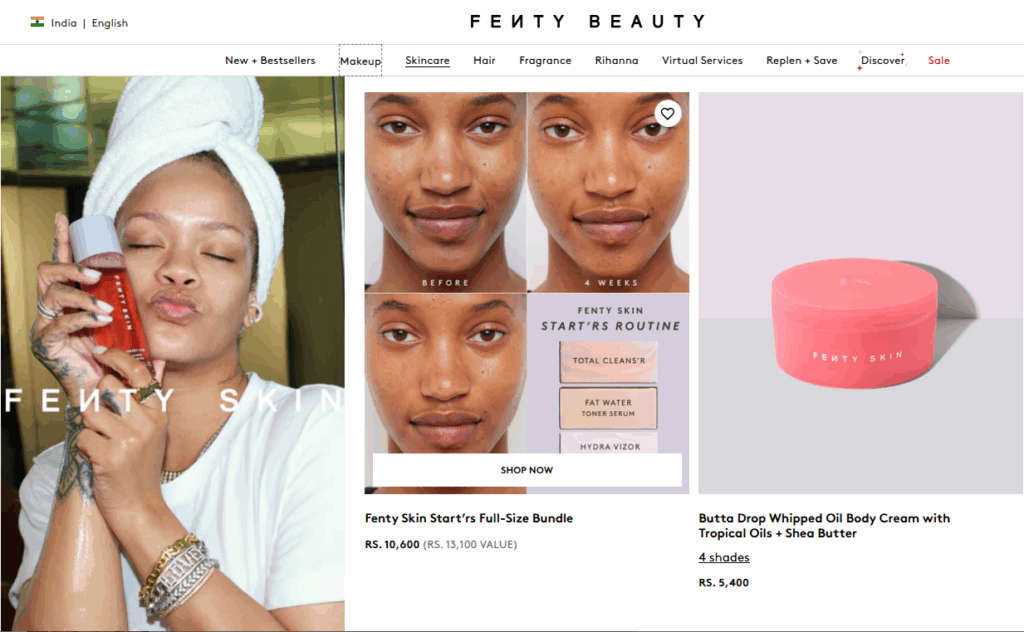
Source: Fenty Beauty
There are several interactive elements you can use on your eCommerce store in the beauty industry:
- Virtual try-ons for lipsticks and foundation shades
- Hover effects for fast info
- 360° product views
- Shoppable videos
- Quizzes and product finders
- Progress bars during checkout
- Quizzes to match users with products
Adding these elements enhances the overall user experience and encourages customers to return to your store more often.
2. Easy Navigation
A typical makeup and skincare eCommerce store typically has hundreds of products. Hence, without clear navigation, it would be impossible for your users to find the right product for them.
As such, you need to invest enough time and effort in designing your site’s navigational structure. Intuitive navigation is a key part of eCommerce UX for beauty brands. That’s why easy and intuitive navigation ranks among the must-have features for makeup and skincare stores.
Leading makeup and skincare brands, such as Sephora, build easy navigation that allows users to access any product category from any other.

Source: Sephora
Consider the following when designing your store’s navigation:
- Implement predictive search with autosuggestions as users type
- Organize your site around main categories and subcategories
- Keep navigation elements in the same place for consistency
- Ensure touch and mobile-friendly navigation paths
- Pair navigation categories with icons or images
You can also improve your navigation based on user behavior and trends, and help your customers find their products in just a few clicks. You can also use site analytics, heatmaps, and A/B testing to do it.
3. Minimal Design Elements
Overdesigning is a fatal mistake many eCommerce stores make. By adding over-designed elements, such as multiple fonts and excessive banners, pop-ups, or sliders, you may overwhelm your users. It can quickly make them leave your site, never to return.
That’s why minimalist design elements stand out among the must-have features for makeup and skincare stores.
Hence, ensure your eCommerce features for cosmetics websites blend seamlessly with minimal design elements to keep the user experience clean.
According to Portent, a website that loads in one second has a four times higher conversion rate than a site that loads in five seconds.
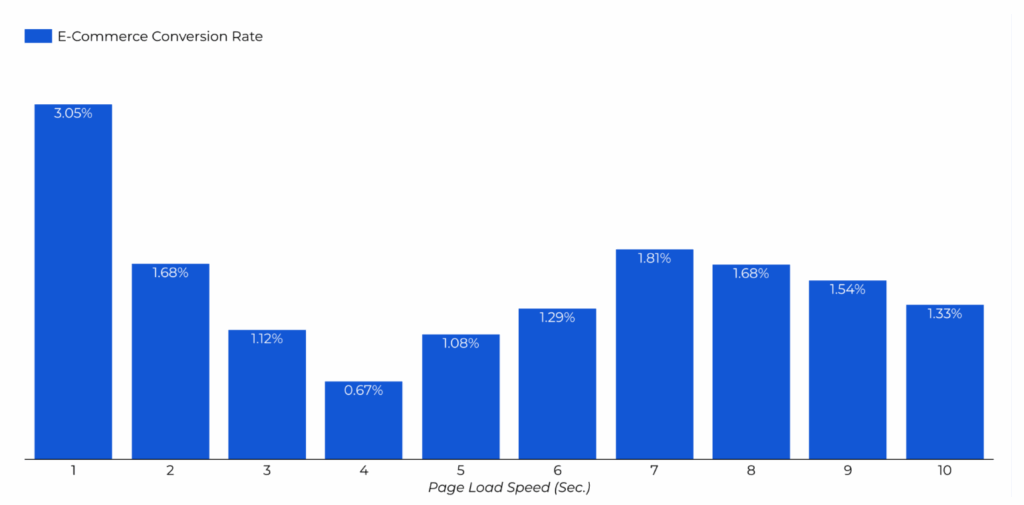
Source: Portent
Apart from improving your makeup store conversion rate, a minimalist layout with purposeful design choices helps keep the attention on the product. As one of the must-have features for makeup and skincare stores, it is much deeper than design.
Hence, when designing your makeup and skincare store, focus on the following elements to ensure a minimalistic design that’s both aesthetic and fast-loading:
- Whitespace to draw attention to products
- Neutral tones that reflect skincare purity
- Clear CTAs without distractions
- Limited typefaces and colors
- High-quality visuals
- Minimal design for a faster and secure checkout process
4. Mobile-friendliness for Better Customer Experience
According to Statista, mobile commerce is expected to account for nearly 63% of all online retail shopping.

Source: MobiLoud
This shows that most of your visitors use mobile phones to access your store. Hence, it is vital to ensure your site is mobile-friendly, loads faster, and offers a seamless shopping experience.
Mobile-friendliness is even more vital for makeup and skincare brands, as 38.4% of total sales in the industry come from online shopping.
Making your site mobile-friendly is more than just ensuring your store loads correctly on different mobile devices and using optimized, high-quality images. It is one of the most important features for makeup and skincare stores. It means optimizing eCommerce features for cosmetics websites to deliver a seamless and engaging user experience on smaller screens is vital than ever now.
Here are a few vital factors to keep in mind:
- Touch-friendly UI with large buttons and swipeable carousels
- Fewer data inputs and autofill options for faster data collection
- Integration with mobile wallets like Apple Pay, Google Pay
- Faster loading speed with lazy loading, image optimization
- Simplify navigation with sticky headers, collapsible filters
Ensure the eCommerce website development and digital marketing agency you hire to work on your store understands what are the best features for makeup and skincare stores.
With most beauty shoppers browsing on phones, even a 1-second delay can kill conversions.
Pro Tip: Discover actionable tactics to boost mobile performance in our guide on increase mobile conversion rate and turn mobile browsers into buyers without losing them to slow load times.
5. Personalization
In its Next in Personalization 2021 Report, McKinsey & Company found that 71% of consumers want businesses to offer them personalized services.
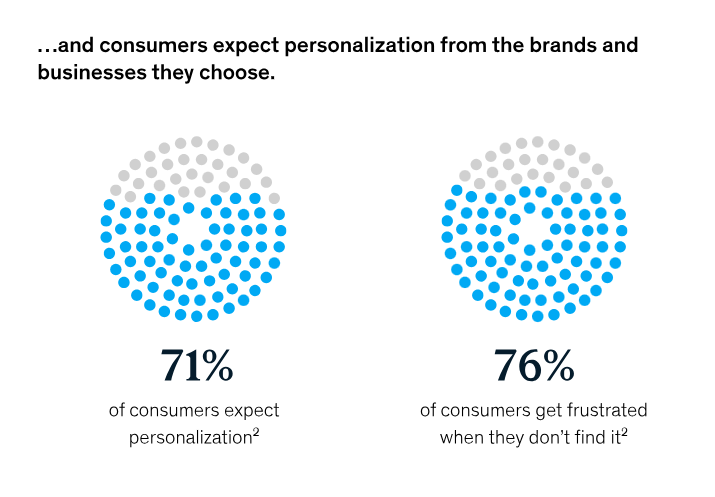
Source: McKinsey & Company
As makeup and skincare are a very personal affair for most customers, the industry thrives on personalization. Incorporating personalization shows them that you care about their unique needs and preferences, and they will come back to you time and again. And using personalization features for makeup and skincare stores is also a smart way to cater to customers with specific needs.
In fact, the Vogue Business Beauty Index states that 70% of consumers prefer to have skin diagnostics and/or color matching while shopping online.
As such, your makeup and skincare eCommerce store can build customer trust by enabling them to find personalized offerings within your store.
Here are a few factors you can use to do it:
- Recommend products based on past purchases or skin profile
- Personalized content like skincare tips or regimens
- AI-powered skin quizzes
- AI features to find suitable products for skin conditions
- Send promotions based on browsing and buying behavior
These personal experiences, partly enabled by the user-friendly and essential features for makeup and skincare stores, help your business far more than just selling products. It helps build a connection with your consumers, which can lead to lifelong partnerships based on trust and value.
Many businesses, such as Sephora, Maybelline, and Guerlain, have seamlessly applied these best practices to make their online stores user-friendly, easy to use, and fast-loading while driving top-notch performance.
These custom features for makeup and skincare stores enable them to serve customers worldwide.
Let’s analyze each of these stores in the next section.
3 Top Makeup & Skincare eCommerce Websites for Inspiration
Here are three makeup and skincare brands that offer a range of features to deliver unique and user-friendly experiences in their online store.
1. Sephora
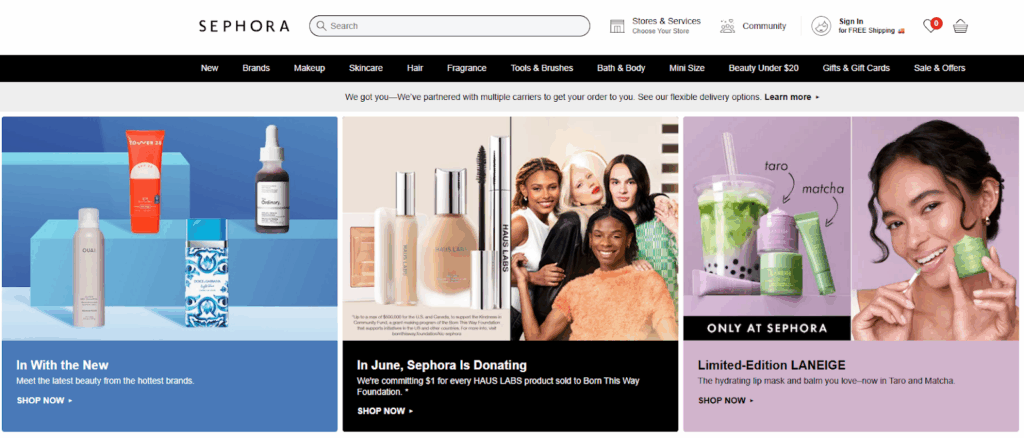
Credit: Sephora
Sephora’s website is a global leader in beauty eCommerce. It perfectly blends cutting-edge technology with a customer-first approach. The site offers an engaging and personalized shopping experience for makeup and skincare enthusiasts.
Here are a few unique features of the store:
1. Virtual try-on & AR tools
The Virtual Artist enables users to try on makeup virtually using augmented reality and choose products that perfectly suit them.
2. Personalized recommendations
Sephora suggests products through the dynamic “New For You” carousels and utilizes interactive quizzes to refine recommendations.
3. Integrated loyalty program
The Beauty Insider program enables users to track points, redeem exclusive rewards, and access app-only promotions.
Sephora’s success demonstrates how combining virtual try-on technology with a well-integrated loyalty program enhances engagement and retention. You can also adopt the features for makeup and skincare stores that Sephora uses to offer a personalized, interactive, and rewarding customer experience.
2. Maybelline
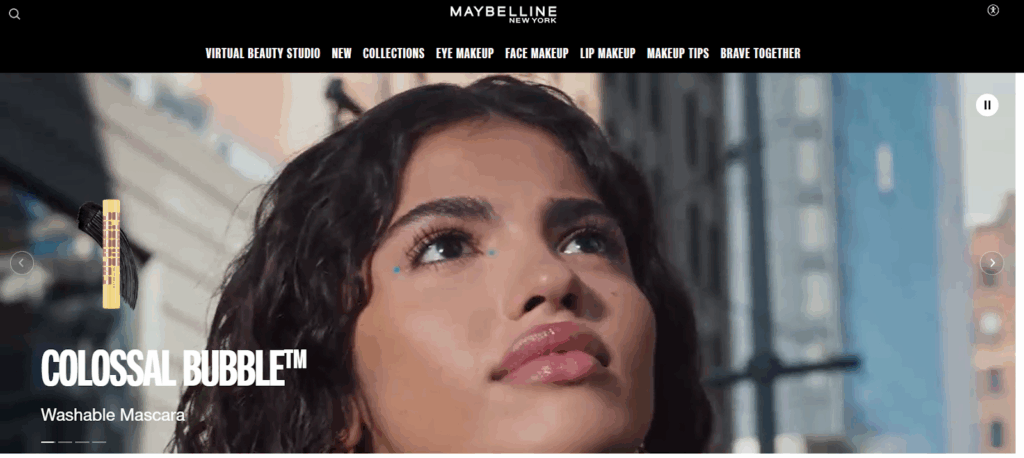
Credit: Maybelline
Maybelline has a dynamic and user-centric platform that uses technology and inclusivity to offer easy and personalized product discovery. And businesses looking to find the best features for makeup and skincare stores can learn a lot from Maybelline.
Here are a few top features of Maybelline’s online store that define the brand’s personality:
1. AI-enabled product finders
The brand offers interactive quizzes, including Foundation Finder, Primer Quiz, and Fit Me Finder, which utilize AI and user input to recommend personalized products.
2. Advanced navigation and filtering
The site features a clean navigation system, where products are organized into clear categories and enhanced with powerful search and filter tools.
3. Community integration
Maybelline encourages user-generated content through hashtags like #Maybelline and integrates social sharing directly from its virtual try-on feature.
Beauty companies looking to grow in the industry can utilize interactive product discovery tools and personalized experiences, as offered at Maybelline’s store, to understand customer behavior and customize experiences for higher conversion rates and foster loyal customers.
These features for makeup and skincare stores can certainly help you grow and build a loyal customer base.
3. Guerlain
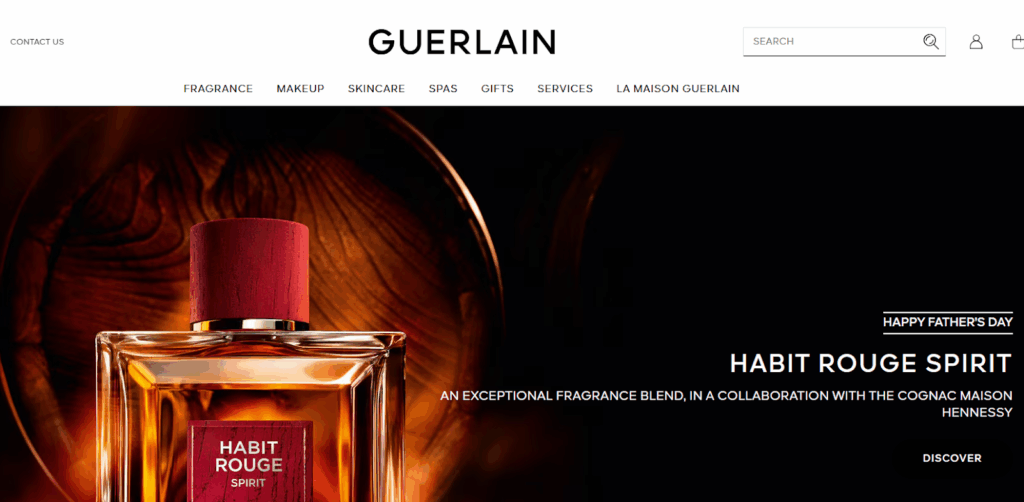
Source: Guerlain
Guerlain’s online store blends heritage luxury with advanced technology, offering a refined and inclusive digital shopping experience.
Here are a few top features the store offers:
1. Immersive product discovery
Its visually rich navigation, detailed product stories, and complimentary samples make product discovery a fun and exciting experience, fitting its brand identity.
2. Guerlain&You loyalty program
The Guerlain&You program rewards loyal customers with points for every purchase, unlocking exclusive privileges and making their users’ eCommerce journey existing and cost-effective.
3. Masterclasses and personalized consultations
Guerlain hosts online and in-store masterclasses and beauty consultations led by expert professionals.
Brands looking to develop a makeup and skincare eCommerce store can take a leaf from Guerlain’s book and utilize the following features for makeup and skincare stores to offer a better user experience:
- Masterclasses
- Personalized consultations
- Immersive product discovery
Inspired by these leading beauty brands? Building a high-converting beauty store requires more than just copying features; it demands strategic UX design tailored to your audience. Before investing in development, understand the complete investment required.
Pro Tip: Check out our breakdown on how to build beauty eCommerce store to see realistic budgets, timelines, and must-have features that deliver ROI for beauty brands.
Implement These Features for Your Makeup and Skincare Store
The essential features for makeup and skincare stores that we have discussed in the blog post can help attract new customers and retain your current ones. These features help users easily find products that meet their preferences, catering to a range of needs based on skin conditions, lifestyle choices, ingredient preferences, and more.
While these features for makeup and skincare stores are an excellent choice to add, you still need to determine which one might have the greatest impact on your makeup and skincare eCommerce store.
For that, you need to work with an eCommerce development agency with expertise in successfully implementing these features. With years of experience and serving eCommerce clients from diverse parts of the world in the beauty market, Aureate Lab can help you.
We can audit your website to determine which features for makeup and skincare stores could contribute to increasing your store’s conversions.
Our team has helped numerous health and beauty brands grow their online businesses with customized design strategies and philosophies that align with their brand and target audience.
Book a free consultation call to speak to our expert eCommerce developers and explore how we can help you with building the best features for makeup and skincare stores.






Post a Comment
Got a question? Have a feedback? Please feel free to leave your ideas, opinions, and questions in the comments section of our post! ❤️